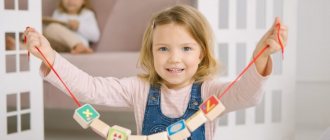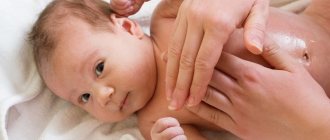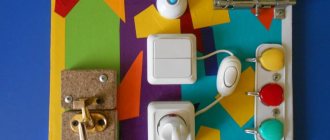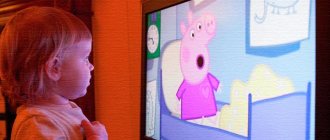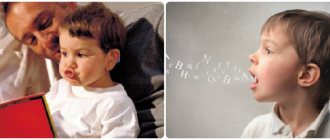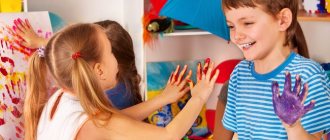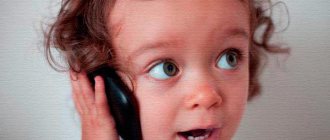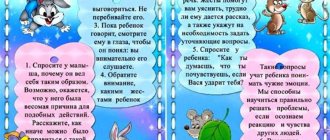By the age of 3 and a half, the baby becomes a full-fledged individual, with his own character, habits, temperament, his own distinctive features and demeanor. He has become a good conversationalist, happy to tell what happened to him that day, where he visited, what he managed to see. At this age, people become aware of themselves as independent individuals with their own will, needs and virtues. Over the past 3 colorful, intense, inimitable years, the child has grown significantly, mastered new experiences, become agile, dynamic and inquisitive.
The baby’s vocabulary at this time reaches one and a half thousand words, and he successfully uses numbers, adjectives, pronouns and adverbs. There is no end to his countless questions, which often perplex parents, and adults require great patience. A child's desire to know all the news is justified. The child wants to be impeccable, he expects to be approved and praised by adults, who are surprised at the independence and independence that has appeared in his actions and character.
Physical development of a child at three and a half years old
Boys aged 3.5 years are well developed physically and actively participate in active and noisy games. Girls talk better, prefer quiet games and choose to spend time in small groups.
When assessing a child's abilities, you need to rely on a standard list of general skills.
At 3.5 years old, a child should be able to:
- run, changing the direction of movement, without slowing down;
- run at different paces;
- avoid obstacles while running, do not fall, jump over small obstacles;
- jump in place on one and two legs;
- jump forward, backward;
- climb children's horizontal bars, hang briefly on the bar by your hands, jump from low horizontal bars, lowering yourself onto bent legs;
- ride a bicycle, ride a scooter;
- walk along narrow curbs, surfaces with a slight slope, while maintaining balance;
- walk backwards;
- maintain balance for 20 seconds while standing on one leg;
- climb stairs without the help of elders;
- go down the stairs, alternating legs and occasionally using an extension step;
- jump on low curbs and steps;
- lie on your back, raise your legs and hold them in this position for about 10-15 seconds;
- walk on tiptoes, on the outside and inside of the foot;
- play with the ball, be able to catch it with one or two hands, throw it above you;
- throw the ball at the wall and catch it after it bounces.
What a child should be able to do: table by age
| Age | Physical development | Speech development | Development of intelligence | Emotional development |
| 3 years | Jumps, runs; can climb a ladder; has excellent control over his body; throws and catches the ball; knows the location of many objects and their purpose; undresses and dresses independently; controls going to the toilet; Tells adults when hungry. | Knows his first and last name; knows a lot of words. | Interested in the world; can recite a short poem; often asks educational questions, demands explanations of objects and everything that happens around them; says “thank you”, “please”. holds a pencil and can draw simple lines; assembles puzzles from 2-3 parts; knows how to group objects by color, shape; name at least 2 colors; know the name of some geometric shapes; freely assemble a pyramid of 10 rings or more. | The child gets used to kindergarten; reacts negatively when scolded; wants to dress and eat himself; when obedient, wants praise; inquisitive and curious; memories appear that the child recounts; is happy when something works out. |
Features of the psychological development of a baby in the fourth year of life
Children in the third year of life strive to understand everything that surrounds them, and are happy to study what their parents offer them. In moments of crisis, when a child throws groundless tantrums, you should talk to him calmly, gently seeking understanding on his part and overcoming psychological discomfort.
Over the course of 3.5 years of life, the child has already learned well to detect any changes in the home atmosphere and the behavior of the people around him, so it is worth talking more often about love for him and his significance. With affection shown by parents, children become more balanced.
A child at this age can already concentrate on one task for 20 minutes. It is best to alternate different types of activities so that interest in tasks and games does not disappear.
Parents should pay attention to improving their children's speech and social skills. Psychologically, they are already developed enough to understand what friendship is and what it is built on, and how to resolve conflicts that arise. Through short conversations on topics about the feelings of other people, you need to teach the child not only to assess the situation from his own position, but also to look at what is happening from different angles.
Features of the development of speech and social skills at 3.5 years
Exercise option for the development of a 3.5 year old child.
At 3.5 years old, a child can already:
- count to 10 and back;
- navigate concepts such as “many”, “little”, “high”, “long”, etc.;
- know the names of primary colors and shades;
- find differences between two pictures and explain what the discrepancy is;
- compare similar items;
- find an extra one in a group of objects, justifying your decision;
- remember sequences of words and phrases;
- clearly explain the difference between a city and a village, a tree and a bush, etc.;
- navigate the types of plants, talk about the characteristics of the most common shrubs, flowers, trees in your native region;
- describe natural phenomena;
- explain, by feeling the object, what it is made of, what shape it has;
- tell the difference between day and night, autumn and winter, etc.
The main attention should be paid to the child’s speech development. Already at 4 years old you can start learning letters and syllables.
Nuances of the psyche of three-year-old children
The developmental characteristics of 3.5-year-old children indicate big changes in their emotions. Children develop a sense of self-esteem, they are proud of themselves that they can do something better than anyone (jump, play), that they have the best parents: the smartest dad, the kindest mother. They develop an understanding of humor; cartoons or comical life situations make them laugh. Kids notice beauty and ugliness in nature and in life and can appreciate it.
A child can react emotionally in different situations:
- empathy if someone nearby is feeling bad or in pain;
- help, if he can do it;
- responsiveness: if the parents are tired, he will not interfere with their rest;
- sympathy for the heroes of fairy tales and cartoons: he can be happy, sad, angry with them;
- understanding that he acted badly makes him sad and ashamed;
- experience in anticipation of a negative assessment or censure from adults.
A child can harbor a grudge for a long time if he is punished. But he sees when someone else acts badly and evaluates such an act negatively: you can’t do that. Sometimes you may encounter exaggerated feelings of jealousy or resentment. And there is no need to teach him pretense and cunning, pranks and pranks. A sense of caution is being formed, a distinction is made between the concepts of danger - safety, harm - benefit, anxiety and fear of the dark may often appear. A three-year-old child can complete verbal three- or four-step instruction. The child’s compliance increases, he begins to realize the possibility of delaying the immediate fulfillment of his desires. With the right parenting, three-year-olds can hold back emotionally.
The main activities of parents for the development of a 3.5 year old child
For comprehensive development at 3.5-4 years of age, it is necessary to combine several types of training during one lesson. So, during the morning warm-up, you can not only perform physical exercises, but also count the number of jumps made and name the objects used.
Physical
At 3.5 years old, you need to walk with your child at least 1.5 hours a day. For full development, it is preferable that he communicate with peers. Parents can take the initiative in this: gather children in a group, introduce them, offer exciting games.
An integral part of the day for a child at this age is morning warm-up. During it you need to do light exercises for all muscle groups:
- Swings, ball games, and exercises on the horizontal bar are suitable for developing arms and shoulders;
- for the back muscles you need to do bending, gymnastic exercises on a fitball;
- to strengthen the legs - running with alternating tempos, side steps, jumping in place and in length;
- To improve coordination, you need to learn to walk in a straight line, stand and jump on one leg.
For a morning warm-up, 20 minutes will be enough.
Speech
At the age of 3.5 years, children already use grammatically complex structures in speech and do it correctly. Difficulties arise in the pronunciation of sounds. To correct deficiencies in pronunciation, articulatory gymnastics is used.
All children between 3.5 and 4 years of age should see a speech therapist to get a professional assessment of their language skills and to understand what needs to be worked on. Problems are easiest to fix in the early stages.
Speech development is considered normal if by the age of 4 the child stops pronouncing babbling words and correctly uses forms of tenses and cases. If previously children could talk about themselves not in the first person, then by the age of 3.5 years this feature disappears. Children learn to memorize quatrains and retell short stories.
Speech training with your child is very necessary.
To promote a child's speech development, parents should:
- discuss what is happening with him, in the evenings remember what happened during the day;
- read short stories, books, discuss the plot, ask the child’s opinion about what they read and offer to retell certain parts;
- do articulatory gymnastics, ask them to repeat sounds after adults, stretch their facial muscles;
- show the child photographs and pictures, discussing what is depicted on them and wondering what events could have preceded what he sees;
- Invite your child to compose stories on their own; at first, you can rely on cards and illustrations, and come up with stories about surrounding things.
Cognitive
Children's horizons broaden most quickly through play. It is recommended to determine what type of information perception is suitable for your child (sound, tactile, visual), and build on this when preparing games and exercises.
For children who find it easier to assimilate information through hearing, classes in the form of a conversation, writing stories, and discussing events are suitable. For visual learners, you should create a lesson using a large number of pictures, illustrations or video materials.
For kinesthetic learners, it is necessary to create conditions in which they can receive information about an object through touch. It’s good if you can combine different forms of exercise and offer the child all types of tasks, focusing on those that are most useful for him.
At this age you need to improve:
- the ability to find similar and distinctive features of several objects;
- the ability to retell the plot of a story, a cartoon seen, a children's play;
- writing stories based on the order of pictures;
- the ability to sort objects, generalize them into groups based on similar characteristics;
- the ability to distinguish colors and their shades;
- knowledge of what figures look like;
- ability to count to 10;
- correct use of the concepts “low”, “high”, “many”, “little”, “big”, “small”, “edible”, inedible.”
To develop children's horizons, it is necessary to replenish their knowledge base about the world every day.
Parents should share information with their child about:
- wild animals, the places in which they live, their external features, behavior and interaction with nature, the sounds they make, the benefits they bring;
- insects, inhabitants of seas and rivers, birds and what helps them live in water or fly, what they eat;
- the world of plants, flowers, mushrooms, trees and what they consist of (leaves, stems, roots, etc.);
- natural materials, methods of their use (what is made of glass, plastic, stones, wood), what they feel like;
- natural phenomena, seasons, rules of behavior during rain, hurricane, thunderstorm, in the sun;
- important dates and why these events went down in history, what significance they have for people;
- family traditions and their meaning;
- the structure of the human body, the functions of the main organs (heart, lungs, stomach, brain);
- professions of parents and relatives, the merits of their work;
- methods of transportation (planes, cars, trains, ships), the structure of various types of transport and areas of their use.
It is necessary for children to learn something new.
Musical
Dancing to a given tempo, feeling the rhythm of the music, trying to distinguish between musical genres - this is what a child aged 3-5 should be able to do. There comes an understanding that they move at different speeds to different melodies.
In the process of studying musical genres, you need not only to listen to the compositions and look for their characteristic features, but also to show the child which of the familiar movements are suitable for dancing to the chosen melody. You can learn children's dances: “I was in the kindergarten”, “Birch”, “Dance of the little ducklings”, etc.
The thematic lesson should be combined with an introduction to types of professions related to music. The child must learn who singers, musicians, composers, conductors and dancers are. While a symphony orchestra concert may seem tiring for children, attending a dance event where you can see how beautifully people move to different music will be a good time for a child.
Touch
The ability to fantasize and create objects for new games from scrap materials is becoming increasingly important in the lives of children. Sensory plays an important role in this process. Receiving information through hearing, touch and vision, a child can include various play materials in his activities.
You can develop perception through the following types of activities:
- sorting small objects, creating applications, crafts, playing with small objects, which not only help to establish the process of perception, but also develop fine motor skills;
- playing with a rag bag into which small toys are collected (the child, by feeling the opaque bag, must determine what things are in it);
- games on massage mats;
- on a walk, you can invite your child to listen to the sounds of nature, and at home, with his eyes closed, he can determine what an adult is making noise with (a plastic bag, paper, etc.);
- distinguish the smells of food and flowers;
- activities using materials such as cereals, sand, water, stones, branches.
Fine motor skills
Fine motor skills develop through games that involve the fingers.
At this age, children willingly play with:
- puzzles, wooden cubes;
- cereals, beads, buttons, decorative stones;
- mosaics, clothespins, lacing, plasticine;
- designers.
Another exercise option for a child 3.5 years old.
The best way to develop motor skills is constant creative activities: modeling from clay, painting plaster blanks, creating crafts from dough and natural materials, bracelets from beads, drawing with finger paints, felt-tip pens and pencils, cutting out various shapes, flowers, snowflakes from paper.
Creative
Learning to understand what is beautiful for them and what is not, forming aesthetic taste, expanding knowledge about the world of art - this is what a child of 3.5 years should be able to do. At this age, you can already introduce your child to painting and talk about what methods of creative expression exist.
Invite your child to look at any picture he likes. Ask what is depicted on it, what plot the artist wanted to recreate. Discuss with your child your impressions of what you saw and ask what emotions the image evoked in him. After the conversation, you need to tell what technique the picture was made in, and after that you can try to draw something in a similar manner with your child.
Social adaptation
Closer to 4 years, the first friends appear. Difficulties arise due to the fact that the desire to communicate is great, but the skills of social adaptation are absent. Therefore, you need to discuss with your child how to behave correctly with adults and with your peers, where to give in, when to take the initiative. Adults should be told how to meet a new friend, how to invite him to play together.
Weekly exercise program
Exercises that will help your child develop all the necessary skills:
- Monday: thematic lesson “Trees and Shrubs”, the game “Guess what’s in the bag”, listening to birdsong and the sound of waves, memorizing a poem about summer, sorting through peas and beans, creating an application “Flower Garden”.
- Tuesday: learning about professions, toy bowling, repeating a poem about summer, memorizing the song “Antoshka”, reading the fairy tale “Kolobok”, mosaic “Letters and Counting”, drawing the sea and sky.
- Wednesday: learning letters and syllables using cubes, playing to guess sounds, repeating the song “Antoshka”, drawing a yard with a house and flowers, modeling dough.
- Thursday: playing with a construction set to study shapes, drawing with sand, learning the “Birch” dance, cutting out snowflakes and flowers from paper.
- Friday: thematic task “Numbers and Counting”, game “Where the Ball Hid”, repetition of “Birch Tree”, composing the fairy tale “Kolobok” using cards, game with lacing, sculpting an animal from plasticine.
- Saturday: thematic lesson “Animals in the Wild”, water games, listening to Vivaldi’s composition “Seasons, Winter” and discussing the emotions it evokes, drawing any animal, analysis of the saying “Time for business is time for fun.”
- Sunday: acquaintance with the inhabitants of the sea, applique from scrap materials, home concert for relatives with the performance of a poem about summer, the dance “Birch” and the song “Antoshka”, repetition of the studied letters, making a hedgehog from plasticine and matches, depicting your mood using paints.
The development of a 3.5-year-old child directly depends on the efforts of the parents, so it is important to find suitable games and activities that will help the child explore the world.
Prevention of deviations from the norm
The most common cause of deviations is underweight, this is associated with loss of appetite and impaired digestion of food. Excess weight also appears due to poor nutrition (eating fatty foods, sugars) and a sedentary lifestyle.
Eliminate carbonated drinks and adjust your daily schedule by replacing passive games with active ones. A timely appointment with a pediatrician will help rule out serious illnesses. Vitamins and other medications are prescribed to support the immune system.
